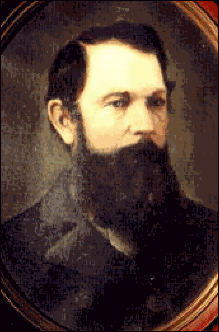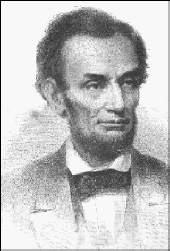|
Recruitment

When the message of Lincoln's call
for troops reached Ohio, the reaction was immediate. An Oberlin College student later
wrote: "War! and volunteers were the only topics of conversation or thought."
The r eaction was similar from some young Shelby County men. Within 48 hours of the
president's message, Dr. Albert Wilson (shown at right), a 48-year-old Sidney physician, became the first
Shelby County, Ohio volunteer. He traveled to Dayton and signed on as a surgeon with the
1st Ohio Volunteer Infantry Regiment. eaction was similar from some young Shelby County men. Within 48 hours of the
president's message, Dr. Albert Wilson (shown at right), a 48-year-old Sidney physician, became the first
Shelby County, Ohio volunteer. He traveled to Dayton and signed on as a surgeon with the
1st Ohio Volunteer Infantry Regiment.
One of the first units formed after President Lincoln's announcement was Company
F of the 15th Ohio Voluntary Infantry. Just four days after the call for troops, 100 young
men from Sidney signed up for Company F. Led by Captain Abraham Kaga, the Sidney soldiers
bore the last names of many families living in the county today, such as Ginn, Gamble, LeFevre, Miller, Swigert, Sharp, Burns, Staley, Moyer, Williams, and many more. The men were
mustered out of service in August of 1861 after their 90 day enlistment expired, but most
immediately re-enlisted for 3 years.
Not everyone stepped forward with such ease. At
Ohio Wesleyan University, a freshman student named Henry
O. Dwight also pondered his future. (Dwight would become a private, sergeant, and
finally a lieutenant with the 20th Ohio, the regiment in which many Shelby Countians
served.) Dwight's memoirs and notes, which were published after the war, give a vivid
account of the life and death that was the lot of a Civil War soldier.
Dwight wrote of his decision to enlist: "At
last came the battle of Bull Run (April, 1861). Thus we all knew that the time had
to come for action." The patriotic fever did not have the same effect on all the
students, however. When some of the 100 members of his local college militia company were
lined up and asked to volunteer for military service, only Dwight and fellow student V. T.
Hills stepped forward.
To ease the difficulties of recruiting, the
prospective soldiers were promised they could serve with their relatives and friends. For
example, an entire regiment, composed of 1,000 men, was recruited from the town of Flint,
Michigan, and its mayor signed on as the commanding officer. Large numbers of boys from Port Jefferson enlisted with the 99th Ohio. Company
C of the 118th Ohio contained many soldiers from Ft. Loramie and Cynthian Township.
Friends from Sidney served together in the 20th Ohio.
This policy helped
ease the pain of homesickness, but when tragedy struck, the results were devastating.
Cousins William Penrod and John Chambers of the 99th Ohio were both wounded at the Battle
of Stones River. Asa and Mary Hardisty lost three sons. Nineteen Shelby County families had more than one son who did not return.
For example, Dinsmore Township brothers Robert and Mathias Elliot
enlisted on the same day. They were killed side by side within minutes of each other at
the Battle of Atlanta. Brothers Alfred and Aaron Swander, two
sons of David and Lydia Swander, never returned home.
The ages of the new recruits varied
widely. Several soldiers, such as Thomas Powell, were just 16 years old, and Dr. Wilson
(shown at right) was probably the oldest at 48. As manpower reserves dwindled in the
south, the Confederates signed up younger boys. Peter Milton Morgan, a local member of the
118th Ohio, noted in his journal on July 22, 1863, "There was 2 Boys came by here
that belonged to the 8th and 9th Tennessee. But they was only 12 years old."
Recruitment in Sidney was accomplished principally by means of
newspaper advertisements and posted hand bills. Captains from various regiments came to
Sidney to sign up new soldiers. Typical was this August 21, 1863, "Sidney
Journal" notice: "Recruits wanted: Capt. Hestler is here recruiting for
the 9th Ohio Cavalry...Capt. Hestler can be seen at Thorn's Hotel." Captain
Hawkey, recruiting officer for the 99th Ohio, placed a September 4, 1863, ad in the "Journal"
asking for "Able-bodied young men, desirous of enlisting in a crack regiment..."
He promised, "Good board and lodging will be furnished from date of
enlistment."
Many boys from Shelby County, Ohio
traveled to other cities to sign on with friends and relatives. For example, Sidney farmer
David Crumbaugh volunteered with the 55th Illinois. He did not survive the war— one
of three Crumbaugh brothers who died. James Quartman traveled to Indianapolis, Indiana,
and signed on with the 2nd Indiana cavalry. He never made it home. Those seeking to join a
particular unit in the army other than the infantry usually had to travel to find one.
C. L. Ruggles,
who ended up being a famous Union spy and scout, was a member of the 20th Ohio with Dwight and many others from Shelby County. In his
memoirs, Ruggles recalled: "In August, 1861, I visited the principal cities in
Ohio, in search of a company of sharpshooters, in which to
enlist. I found several such organizations, but none were offered by men who suited me.
While in Columbus, I met Lt. Downs of the 20th Ohio with a squad of ten men. Liking the
appearance of the men, I enlisted, on the condition that he furnish me an Enfield rifle."
To many a young man, the prospect of fighting a
war was viewed as an adventure. Some familiar with the matter tried to inject a dose of
reality into the mix. While Union General William Tecumseh Sherman was in Columbus for a
recruiting stop in May of 1863, he told the assembled audience: "There is many a
boy out here today who looks on war as all glory, but boys, it is all hell." As
it became apparent that the fight with the Confederacy was not going to be won as quickly
as many first thought, men who subsequently re-enlisted were asked to serve for three more
years.
President Lincoln also instituted
a draft in the summer of 1863. The law was passed in response to fears in the North that
the Confederates would soon invade. The law compelled men between 20 and 45 to enroll, but
it also allowed a man to pay a 'commutation fee' of $300 to escape the draft. Unpopular
from the beginning, the law allowed such men as Andrew Carnegie, J. P. Morgan, and the
fathers of Theodore and Franklin Roosevelt to avoid the war. Mary Staley of Perry Township
wrote to her husband, David, on May 22, 1864,
commenting that their friend "William Rodehammel was here last night. He hired a
substitute for 50 dollars to go in his place."
A Military Committee in Shelby County, Ohio, which included Judge
Cummins and Julia Lamb, was formed to scour the county for
every available young man fit for service. A June 12, 1863, "Sidney Journal" notice commanded the citizens to assemble the next day on the courthouse lawn "at
the ringing of the bell" in order to adopt measures to fill a 1,000 man regiment.

President Abraham Lincoln
'Civil War'
segment written in July, 1998 by Rich Wallace
[ Back to Civil War Index ]
|

